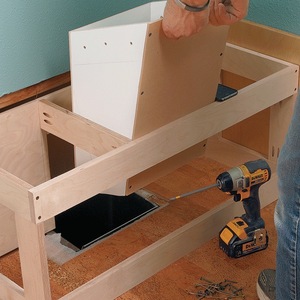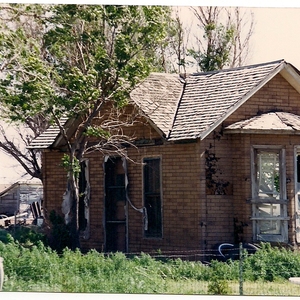Ok first, much respect to all of you that do this for a living. I admere all your work that I see here on Breaktime. I have been building and repairing things for many years, but do not do this for a living.
I am in the middle of a big deck project on my house and have a quick question. The deck is 26 x 14 with the 26 feet against the back of the house. I am at the point of putting down the 5/4 decking but will inevitably have to but joints over the 2 x 10’s. Is there anyway to do this without just butting them together. I was thinking of cutting them at 45 degree angles, but thought they were open up and lead to trouble down the line. Then I thought of over lapping them on the joist by removing half the material on each and joining.
Any suggestions would be greatly appreciated. I will post some pictures after I take them tonight after work.
Thanks,
Barney


















Replies
I have done this with 3/4" mahogany & have had no problem. I used a pre finished square drive ss deck screw & predrilled the holes.
Thank you for your response. I assume you were talking about the "lapping". My only concern was that perhaps there might be a structural lapse on that joint.
Barney,
What type of 5/4 board?? PT SYP will shink a lot and I would suggest a butt joint. Other materials could be laped or cut at 45.
Thank you for getting back to me. I appreciate it. I'm using 5/4 pressure treated. It looks like basic concensis is butt joints. I read Mike Smith's post below about the shrinkage with 45 degree cuts at the joints.
If you are using a hidden fastening system a butt joint will look fine, but with an exposed screw I'd rather see 2 screws per 1x4 including joints. I used the bevel cut to allow 2 screws rather than 4 which I think is all that makes the butts more noticeable.
Cut the ends to 45 degrees.
Make the 45 joint overlap at a joist and you can screw through both boards. This will pinch the joint, and you wont have an edge lifting up to catch any toes...
Why do you not like the butt joints? Wood expands and contracts across the grain, not lengthwise. Butt joints will not open up because they are across the length, if you 45 the boards then you'll get gaps because the board is shrinking across the width. If your using pressure treated, it will shrink a lot. Also if you are using a synthetic then the gap will expand and contract a lot.
I would stay with the butt joints, its a deck, no one notices them and you can get them tight. If you do 45's, I think you are just calling attention to the joints and detracting from the nicer parts of the deck like the balusters, railings, etc.
barney... that 45 detail is not a good idea on decking... the long point may warp and bend up .. then it will either cut someone's foot or get broken off
i'd stick with the olde tried and true butt jointMike Smith Rhode Island : Design / Build / Repair / Restore
recently saw a pic of one where the decking was laid out more like flooring.
looked to be 4ft boards ... staggered seams ... butt joints ... and the butt end rounded over with a router.
followed the old logic of "if U can't hide it accentuate it".
think it was ipe or something pretty like that ... bet that design would look good with most any product. Pattern reminded me of an engineered floor I laid ... similar size/proportion boards.
Jeff Buck Construction
Artistry In Carpentry
Pittsburgh Pa
Thank you for responding. I appreciate your insight. It appears that the basic concensus is butt joints. So that will be the way that I go. I was just concerned about cracking and spliting.
BTW, I have been reading your "Adverse conditions" postings. You do great work. That house looks great.
Thanks again.
Wood shrinks lengthwise as well, just not as much as it shrinks in width. And if all the wood is of roughly the same age and degree of dryness then the framing will shrink the same amount as the planks, leaving the joints about where they were in the beginning.Put put new wood on old framework and you'll see shrinkage.
If Tyranny and Oppression come to this land, it will be in the guise of fighting a foreign enemy. --James Madison
Dan, I don't think what you have said is necessarily true in regards to wood shrinking equally. Even in same species applications it doesn't hold true. When we frame a brand new PT deck.... framing and decking all new.... we don't gap the deck boards. Two or three months later (depending on the time of year) there are gaps in the deck boards ranging from 1/4" to almost 1/2". Even with more stable woods like mahoghany I find that the gapping increases with time even on a new frame... obviously not to the same degree as PT, but the shrinkage still occurs at different rates due depending on orientation, species, moisture content, etc.
Ever kill yourself mitering deck boards around a wrap around porch? LOL... it's heartbreaking when you come back a month or two later to find all your nice tight miters have opened. That's why we now run a feature strip down the middle of the joint and butt the 45's to this, either that or we weave the deck boards in a herringbone pattern.View Image
I said the boards shrink UNequally in the two directions. This is why the gaps grow between adjacent boards on a deck. The framing is shrinking too, but only maybe 1/4 as much as the width of the boards.
If Tyranny and Oppression come to this land, it will be in the guise of fighting a foreign enemy. --James Madison
Sorry, I thought you said the shrinkage in framing and the shrinkage in decking would be more or less equal and cancel each other out... leaving no noticeable gap in the joinery. My bad Dan.View Image
Yeah, I did infer that too, I guess. But that's "more or less". There'll still be differential shrinkage in length, especially between different species or levels of wood treatment/dryness, but not nearly as dramatic as the difference between length shrinkage and width shrinkage.It pays to have some old wood stored in a reasonably dry place for use when patching things.
If Tyranny and Oppression come to this land, it will be in the guise of fighting a foreign enemy. --James Madison
Thanks for getting back. I was concerned that the butt joints wouldn't look as nice and perhaps there would be cracking at the ends. But since I'm going to pre-drill the holes I should be able to avoid that from happening.
Thanks again.
Like Diesel mentioned, pressure treated shrinks a lot. Do not leave a space in between the boards when you install them. Other decking that doesn't shrink as much you'll use a nail to space or something like that. With PT, push them all tight and in a few months they will dry with the necessary gap. If you leave a space installing, the shrinking will leave a very large gap, much too wide.
I'm not a fan of PT, in fact I hate it. As one breaktimer put it a few weeks ago, 'when you finish a PT deck, take a picture because it will never look as good again'. In MA, 1x4 mahogany decking (I think its really meranti) is only a little more than PT and a much nicer look. That could be an option that you may not have known about.
Thanks for the response. When I was in college during the summer I worked for my uncle building decks, so I had learned about the spacing and the shrinkage. So I have already planned the tight layout. As for the pressure treated, since this isn't going to be the be all end all house and we are going to sell it within a year, the wife and I didn't want to make the investment in trex or other composite. We thought we would wait till we had "the house" of her dreams to use the composite.
I can understand that, the added cost probably won't get you much back on the sale.
Here's a penetrating finish that you might use to enhance it a bit when you sell. I, and most here use this brand for Ipe (albiet a different formula) but they have this for PT. No experience with it but you might find something in the archives or someone will chime in. The reps at the company are very helpful as well. http://www.penofin.com/products_ptwood.shtml
Thanks. That was going to be one of my other questions. I have experience with PT wood before on all the decks I built with my uncle, but they always needed a good finish.
I want to use something that will make the wood last and still look good... as much as can be expected since its PT.
Hi Barney. My advice is also to stick with the butt joints. Sometimes we'll knock the corner off the end cut with a block plane to clean it up and make it look a little nicer. Other times we'll back cut 'em... just a hair.... so that you get a razor sharp line for a joint.
Either that, or you can run a 'feature strip'... a deck board running perpendicular to all the others and all of your deck boards butting into this. Personally, I don't usually like this look on a regular old rectangle, but I suppose it could be made to look nice.
The butt joints have it. This place is awesome for great advice from professionals just like yourself and the others. I've been a long time reader of FHB and then joined BT a few years ago, but my profile was whipped out in the conversion.
I truly appreciate all the advice they you all offer.
Thanks again.
Don't break what ya can't fix, go with the butt.
Spheramid Enterprises Architectural Woodworks
" I am not an Activist, I am, a Catalyst. I lay around and do nothing, until another ingredient is added"
Yea. stick with the butt. I like the idea of the back cut. We always plain the top corner of the butt...just a little. staggering the joints help them look less noticeable.
keep up the good work
Edited 7/25/2006 4:10 am ET by stewyjay
Thank you for the response. I took pictures last night so I'll post them soon. If there is a major hurricane in my town I know this will be the only structure standing.
I'll post pictures tonight or tomorrow.
Just butt them, Barney. Nice tight square butt joints.
Lapped bevels, whether done at 45 degrees or something under, is not a good idea. It is a bad idea, for exactly the reason Mike Smith describes.
What I like to do is cut a crisp little 1/8" chamfer across the top of each end, before the boards go down, of course, using a sharp block plane. The resulting joint looks like a little crossgrain V-groove.
Also, if face-fastening, I make a simple little drilling jig that places the four holes nicely squared and centered over the butt joint, so that every butt looks identical.
Finally, work things out with your purchased stock lengths and your laid-down boards, so that your butt joints are patterned to be nicely spaced. I like mine on adjacent boards to be no closer that three joist-bays apart.